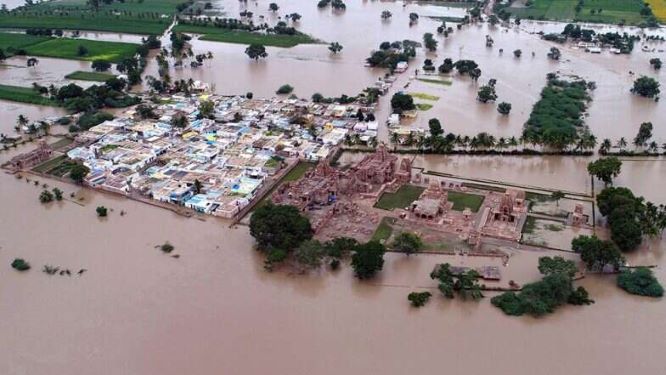

Flood water has inundated vast areas of North Karnataka
The CEEW study attempted to assess the effectiveness of the nationally operated EWS and multi-hazard early warning systems (MHEWS) in mitigating the impacts of hazards like floods and cyclones in the country.
To access the effectiveness of the EWS in the country, the study proposed a new model called as ‘vulnerability to resilience model’. This model estimates the vulnerability based on the integrated vulnerability assessment framework of CEEW. It also estimates the resilience based on the A2E framework i.e, availability, accessibility and effectiveness of EWS and MHEWS.
The latest study claimed that approximately 66 percent of individuals in India are exposed to extreme flood events; however, only 33 percent of the exposed individuals are covered by flood EWS. It also said that 25 percent of individuals in India are exposed to cyclones and their impacts, but cyclone warnings are available to 100 percent of the exposed population.
“There is an urgent need to implement a people-centric and comprehensive Multi-Hazard Early Warning System (MHEWS) at the national and sub-national levels to strengthen existing mechanisms further. India can leapfrog to MHEWS from the existing EWS mechanisms by leveraging new age technologies, involving local communities in the early warning dissemination process, investing in regional real-time flood monitoring micro-sensors, establishing public-private partnerships, and learning from international best practices,” Shreya Wadhawan, Programme Associate at CEEW said.
The report said that most of the exposed population could access early warning information via mobile or telephone. It said that more than 88 percent of Indian states that are exposed to floods and 100 percent of the states exposed to extreme cyclones have a high teledensity ratio too.
“In total, 14 out of 32 states that are exposed to floods, and 9 out of 17 states exposed to cyclones, are highly resilient owing to the availability, accessibility, and effectiveness of EWS and MHEWS.
Furthermore, states such as Andhra Pradesh, Odisha, Goa, Karnataka, Kerala, and West Bengal are at the forefront of building resilience by establishing cyclone EWS,” the report said.
The report, meanwhile, in its recommendations, said that states should mainstream inclusive, impact-based and community-led MHEWS. It also said states should strengthen early warning dissemination systems by leveraging new-age technologies. It also urged states to invest in regional real-time monitoring microsensors.
Reliance Industries Ltd (RIL) Chairman Mukesh Ambani has announced a massive ₹75,000 crore investment in…
Green-energy heavy-duty truck maker Blue Energy Motors has reached a remarkable milestone by surpassing 50…
India is on track to exceed its Nationally Determined Contribution (NDC) target of reducing the…
Raj Process Equipments and Systems Pvt Ltd, a Pune-based technology innovator and engineering conglomerate, is…
Europe’s renewable energy sector faces a potential slowdown, burdened by grid saturation, permitting delays, and…
Hexa Climate has announced the launch of a pioneering afforestation project in Purulia, West Bengal.…